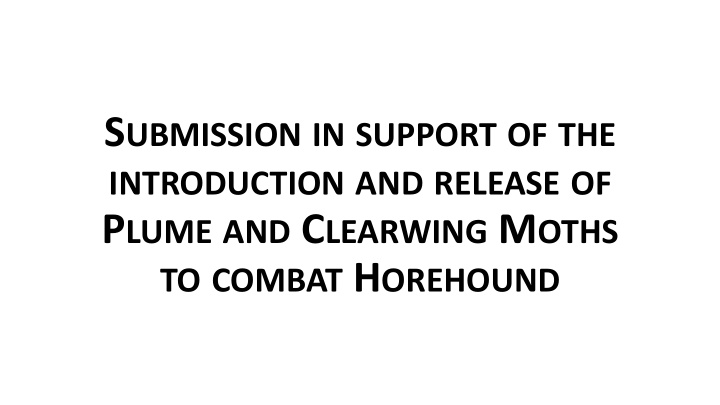



S UBMISSION IN SUPPORT OF THE INTRODUCTION AND RELEASE OF P LUME AND C LEARWING M OTHS TO COMBAT H OREHOUND
• North Canterbury is vulnerable to drought • Dryland farmers in North Canterbury grow Lucerne to mitigate drought effects • Horehound impedes the growth of Lucerne • Current options to combat Horehound in lucerne are inefficient
A scene that is becoming all too common with many Lucerne paddocks in our province This Lucerne paddock (grazed) in the picture below went through a 2-year brassica crop programme to get on top of the weeds with several applications of chemical in that time. It was sprayed once in August 2016, and again in October 2016, at a cost of 145/ha per application. This Lucerne paddock was drilled November 2016. This photo was taken on the 7 th of April 2018, only 17 months after the lucerne was drilled. The darker green plants are Horehound. It cost a total of $723/ha to establish the Lucerne or $950 if cultivated, excluding the 2 years of brassica crops. You would normally expect to get 10+ years out of a good stand of Lucerne; however, these stands won’t last much longer than 2. Horehound plant count 250 plants/ha including small plants.
Horehound in in tr traditional pasture is is costly ly to combat
Two fu further examples demonstrate current methods are in inefficient and expensive The photo taken below shows a paddock that was sprayed successfully on 6 September 2016. As you can see the horehound has comeback almost as thick as it was prior to spraying only 19 months later. This photo taken on 10 April 2018
This photo, shows an area that was also sprayed on 6 September 2016. The photo was taken on the 23 October 2017, only 13 months later. This area has been sprayed again since this photo was taken.
• Horehound has a significantly negative effect on Wool • We support the introduction of Plume and Clearwing moths to combat Horehound
Recommend
More recommend